The Gargoyles: The College’s century-old, somewhat-secret society
March 15, 2023

Since its founding in 1895, the Gargoyle Society has been an active force in representing the student body and improving the student experience at the College. While the existence of the honors society composed of juniors and seniors is not technically secret, the society keeps the details of its regular operations private.
According to a May 30, 1895, edition of Williams Weekly, the society has aimed “to discuss College matters and to take active steps for the advancement of Williams in every branch of College life and work, and to exert itself against anything which it considers detrimental to such advancement.” Throughout its existence, the society has developed a close relationship with the College’s administration to fulfill these goals.
The society took its name from the stone creatures on the sides of Morgan Hall, the Record reported in a March 2005 article. The idea was first suggested by a group of five seniors who believed that the College needed to address certain aspects of campus life. Early delegations focused on rousing school spirit and resolving campus issues, including severe hazing rituals in fraternities and unfairness in student government elections. According to the Record, the society donated the Gargoyle Gate at the entrance to Weston Field in 1903.
Later in its history, the society pursued progressive changes on campus, advocating for the College to admit women and for exchange programs with historically Black colleges and universities, according to History of Gargoyle, 1895-1985. Some programs that continue today — such as the Junior Advisor system and First Days programming — exist because of the society’s work.
Gargoyles have protocols and restrictions to maintain their secrecy. According to Records Manager and Digital Resources Archivist Jessika Drmacich, records of the group held by Special Collections are open to the public eight years after their creation. “As an archivist, I strive to make materials as accessible and open as possible while preserving the integrity of the group or records,” she wrote in an email to the Record. “[The] Gargoyle [Society] also wanted to make the materials as open as possible, while preserving the mythology of the group.”
Documents detailing the Gargoyle’s selection process are not open to the public — even after eight years — Drmacich said. In 2005, the Record reported that students had to propose an improvement to the College in order to be accepted, but it is unclear if this still continues today.
It is known, however, that a tradition exists where graduating Gargoyles “tap” incoming members. The 2005 Record article described a ceremonial gathering at Science Quad, where new members would proceed in a march around the quad. “I got tapped,” said Manny Copeland ’23, one of the current presidents of the Gargoyle Society, who explained that the ceremony has changed over the years, but couldn’t disclose specific details. “I found out a lot [about the society] after I got tapped. Previously, I knew of it in vague terms.”
Copeland and her co-president Stephanie Teng ’23 told the Record that they cannot disclose the group’s inner-workings or recent initiatives but could share the society’s mission. “[We determine which College] experiences are worth trying to enhance or make better so that students can feel safe and protected by the campus and by their fellow students,” Copeland said.
Many Gargoyle alums pursue influential positions after graduation, including several former presidents of the College like Tyler Dennett, Class of 1904, and James Phinney Baxter, Class of 1914. “Roughly half of the buildings at the College are [named after] Gargoyles,” Copeland said. “But [many] are also connected to slave histories, so that’s not necessarily a good thing.”
Other alums maintain their commitment to improving their environments through politics. “[Recent alums participated in] very cool activist movements, legal movements, [and] just general political movements,” Copeland said.
Although the society’s goals may intersect with those of the Williams Student Union (WSU), the striking difference between the two student groups lies with their respective expectations from the student body. “[Gargoyles face] less pressure to have immediate deliverables for the campus,” Teng said. “So we can work on multi-year projects, and we can pass down projects over the years.”
Copeland, who also serves on WSU, said that the Gargoyle allows those who would normally be deterred by the inaccessibility and divisiveness of the electoral process to participate in College reform.
The Gargoyles also have far-reaching connections. “The way that [the society] can talk to faculty, staff, and high-up administration members is different procedurally from officially established channels formed by the College for student representatives,” Copeland said.
In recent years, the society’s secrecy has been used to also protect students of historically marginalized backgrounds. “Students of color or students who’ve been harmed by the College [feel] their fate… is to become an activist when they don’t want to be,” Copeland said. “One thing about the Gargoyle Society is it allows them a position where they can advocate without being known as advocates or activists, because they really should be students.”
Additionally, the society operates as a space for these students to advocate together and rely on each other socially. “[We] have moral support in trying to change things, which I think is very needed to try to do advocacy work here,” Copeland said.
Teng said that today’s Gargoyles maintain the society’s original commitment to improving the College. “[We are] more well-equipped and well-designed to take concrete actions in the present day,” she said.








